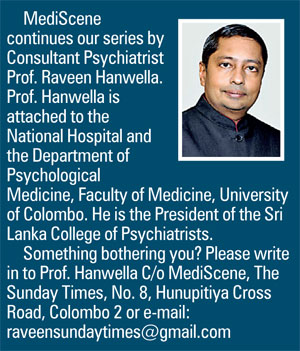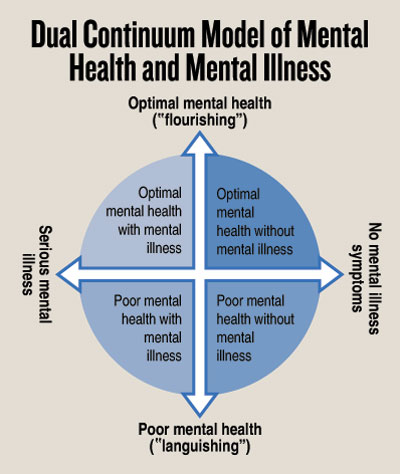Mental ill-health and mental disease – Is there a difference?
View(s):By Prof. Raveen Hanwella
The terms mental ill health and mental disease are used synonymously but are they the same? Is good mental health the absence of mental illness? It would be like saying that good physical health is the absence of physical illness. Let us take two persons both of whom have no physical illness. One person may run a kilometre without breaking sweat whereas the other might huff and puff to even walk the same distance. The difference here is the levels of physical fitness or physical health.
It is important to understand the difference between mental ill health and mental disease, both at the individual as well as the community level. The definitions of the two terms though related are conceptually different. The interventions for prevention and treatment of the two are vastly different and interventions suitable for mental ill health are not suitable for mental disease.
The World Health Organisation in its publica tion Promoting Mental Health published in 2005, defines mental health as, “a state of wellbeing in which the individual realizes his or her own abilities, can cope with the normal stresses of life, can work productively and fruitfully, and is able to make a contribution to his or her community.” This definition has three core components; wellbeing, effective functioning as an individual and effective functioning within the community.
tion Promoting Mental Health published in 2005, defines mental health as, “a state of wellbeing in which the individual realizes his or her own abilities, can cope with the normal stresses of life, can work productively and fruitfully, and is able to make a contribution to his or her community.” This definition has three core components; wellbeing, effective functioning as an individual and effective functioning within the community.
A mental disease is an illness that affects the way people think, feel, behave, or interact with others. There are many different mental diseases, and they have different symptoms. The exact underlying brain dysfunction responsible for most types of mental disease has not yet been identified. Therefore they are classified according to clusters of symptoms that typically occur together. For example to diagnose a depressive disorder a person should have significant lowering of mood for more than two weeks, accompanied by lethargy, lack of interest and reduced ability to enjoy life.
The Diagnostic and Statistical Manual version 5 (DSM 5) published by the American Psychiatric Association is the most up to date manual that classifies mental diseases. In this book around 155 types of mental diseases are identified. Two of the commonest of mental diseases are anxiety disorder and depressive disorder. The two more serious mental diseases are schizophrenia and bipolar disorder. Depressive disorder can range from mild with minimal dysfunction of daily activities to severe depression with a high risk of suicide and total disruption of day-to day-functioning. Severe depression with schizophrenia and bipolar disorder constitute what I would call the big three in psychiatry.
How does mental health or ill health, being free of mental disease or having a mental disease relate to each other? The following diagram would help you to understand the relationship. Taking each of the four quadrants in turn an individual may have, both mental disease as well as poor mental health, no mental disease but poor mental health, a mental disease but good mental health or good mental health with no mental disease. The last combination is the ideal but may be present in only a lucky few. An important point to note is that a person may have a mental illness but yet be able to maintain good mental health.
 The causes of mental ill health are different to that of mental illness. Poor mental health is caused by psychological and social factors such as poverty, poor parenting and upbringing, lack of proper education, and living in restrictive environments or cultures, whereas mental disease is caused by abnormal brain functioning. Mental disease is a disorder of the brain where genetic factors play an important role. It is rarely caused by stress alone and is not a consequence of poor parenting or bad behaviour. It is not the results of personal weakness or deficits in personality or a manifestation of a malevolent spirit. Only in exceptional cases is it caused by nutritional factors.
The causes of mental ill health are different to that of mental illness. Poor mental health is caused by psychological and social factors such as poverty, poor parenting and upbringing, lack of proper education, and living in restrictive environments or cultures, whereas mental disease is caused by abnormal brain functioning. Mental disease is a disorder of the brain where genetic factors play an important role. It is rarely caused by stress alone and is not a consequence of poor parenting or bad behaviour. It is not the results of personal weakness or deficits in personality or a manifestation of a malevolent spirit. Only in exceptional cases is it caused by nutritional factors.
As much as the causes of mental ill health and mental disease differ so do the interventions. This difference is of crucial importance as what works for improving mental health does not treat mental diseases.
Prevention means to keep from occurring. In medicine, there are three types of prevention, primary, secondary and tertiary. Primary prevention aims to prevent a disease from occurring. For example preventing a person from smoking may save that person from developing lung cancer. Immunisation against polio will prevent that disease from occurring in a population. In fact, effective immunisation programmes have almost eliminated the threat of polio in most parts of the world. Secondary prevention aims to mitigate the effects of a disease once it has occurred. For example, if a person develops hypertension, anti-hypertensive medication will maintain his/her blood pressure at normal levels or if a person becomes diabetic his sugar levels could be controlled by insulin or anti-diabetic medication. Tertiary prevention aims to repair or reduce the damage caused by a disease. For example, a person paralysed after a stroke could be helped to walk again by physiotherapy.
Unfortunately for most major psychiatric disorders, there are no known effective primary care interventions. We cannot prevent a person from developing a major depression, schizophrenia or a bipolar disorder. The best we can hope for is secondary prevention where we diagnose the disease at the earliest opportunity and start treatment followed by tertiary prevention to minimise the impact of the disease. It is a common misunderstanding, even among health professionals, that interventions effective in improving mental health will also be effective in the treatment of mental disease. Music, art, exercise, games and meditation may improve mental health but they cannot be used as effective treatments for mental diseases. The primary treatment for depression is anti-depressants or specific psychotherapies, for schizophrenia it is antipsychotics and for mood disorders mood stabilisers.
Unfortunately, patients who have a mental disease, perhaps due to stigma or lack of understanding, may seek alternative therapies with non-psychiatrists hoping for relief from their distress. This is a dangerous practice and should be discouraged. The best hope for recovery if you are unfortunate enough to get one of the big three psychiatric disorders would be to seek help from a psychiatrist as early as possible.
Is there a difference between mental ill health and having a mental disease? Indeed there is and understanding this difference may mean a difference between life and death.


